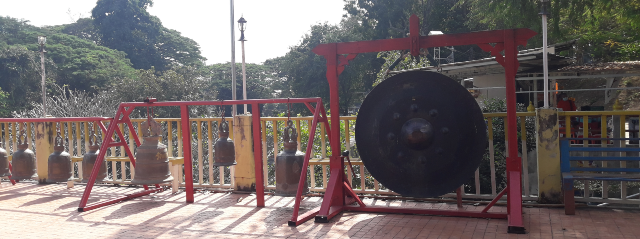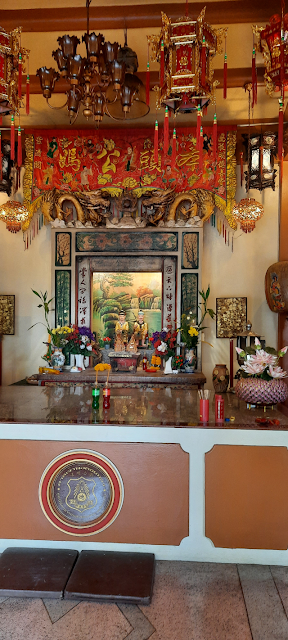Around 20 minutes walk from Wat Phra Kaew on top of a small hillock is Wat Phra That Doi Chom Thong and is considered a sacred site.
It houses the relics of Buddha's hair and right arm bones.
sign from the road
History:
- Wat Phra That Doi Chom Thong is said to be one of Chiang Rai's oldest temples, much before King Mengrai decided to establish his capital here in 1262 A.D.
- According to Yonok Chronicle, a monk named Putthakosa travelled to Sri Lanka and brought a holy relic and gave it to Prince Pangkaraj of Yonok Nakpan who split it into three parts to be enshrined at different places in Chiang Rai, namely Wat Phra That Doi Chom Thong, Wat Phra That Doi Tung and Wat Phra That Chomkitti.
- the chedi was probably built in 940 A.D. during the reign of Phraya Ruen Kaew who was the Prince of Chiang Rai, to enshrine the holy relics
- later in 1260, King Mengrai visited this place and liked the view of Mae Kok valley so much that he decided to make Chiang Rai his capital. He then renovated the wat.
- On the side of wat, is the city pillar which was built in 1987 to commemorate Chiang Rai's 725th anniversary and King Bhumibol's 60th birthday.
What is specail here?
- golden chedi, you cannot miss it
- Buddha images under the Bodhi tree
- red and golden viharn, inside is decorated in green and gold
- stairs leading to a Taoist temple behind the image of Khruba Siwichai and Kaccana
- The Navel Pillars and the water bodies around it
Viharn or assembly hall:
The red and gold viharn is guarded by naga and white lion on either side of entrance. It has been built in Lanna and Ratanakosin art.
entrance to viharn protected by naga and white lions on both sides
entrance to viharn
decorated pillars at entrance to viharn
inside viharn
altar
the main image of Buddha in the most common pose, bhumisparsh mudra or calling earth to witness enlightenment
entrance door
beautiful makar and naga together
Makar seems to be disgorging naga. Makars are reptiles, on looking at the above picture closely, one can see their limbs.Chedi:
The octagonal golden chedi is 14 meters high and shows a mixture of Myanmar and Lanna style in its architecture.
The relics are enshrined here and the chedi is covered with gold foil.
Ubosoth or Ordination Hall:
There is a very small ubosoth with images of Buddha very close to chedi
Buddha images in ubosoth
bells and a gong near the chedi
Some more images around the place:
Very close to the chedi near the Bodhi tree are some images.
Ganesha image
Buddha under an umbrella
Phra Kao Na (Buddha with nine heads)
Boddhisattva of compassion, Gua Yin or Kua Yin
King Mengrai sits facing the chedi
King Mengrai followed the elephants who had wandered off and found them in Doi Chom Thong, a hill on the banks of river Kok.
Phra Song Kad Jai or Phra Sangkatjay or Katyayana or Kaccana. He was one of the prominent disciple of Gautam Buddha. He helped in propogating Buddhism.
Khruba Siwichai
Chinese Taoist temple:
Going down the steps guarded by two golden lions, behind the image of Khruba Siwichai, we saw the Chinese temple. I could find no details on this temple nor was there anyone visiting the place.
golden lions guarding the temple
dragons coiled around a pillar, Yaksha protecting the temple
temple guardian
golden lion
inside of temple
seems like entry to temple, we probably entered through the wrong way
incinerator to burn joss or incense paper which has been used for worshipSan Phra Jao or a spirit house
Sadu or San Lak Mueang or The Navel City Pillar:
Across the chedi, is the City Pillar. It is not a pillar in that sense but is a collection of small pillars. The ground plan faces east and the whole arrangement is a model of the universe.
entrance to City Pillar
"Chiang Rai near gate"
entrance from the chedi side
The City Pillar which was shifted from Wat Klang Wiang in 1992 came to be known as Sadu Mueang or the Navel of the City.
view of City Pillar surrounded with 108 small pillars
The pillars have been built according to Lanna beliefs which reflect a combination of Buddhist and Hindu ideology.
The Navel City Pillar, that is the central one, represents Mount Meru which is the center of universe and sits on a triangular base. It is surrounded by three pillars which stand on a square base. This symbolizes the three planes for attaining nirvana------ Rupabrahma, Arupabrahma and Nirvana
The height of the central pillar is equal to that of Late King's height and the width is five times the width of his fist.
place for worship
The internal pillars are all arranged in tiers in a circle and symbolise universe.
There are five water troughs like this which surround the area. Since, the water is stagnant, it was not clean.These water bodies represent the five oceans or traditional panchmahanadi (five big rivers)-- Ganges, Yamuna, Ajiravati (Saraswati), Sarabhu (Saryu) and Mahi. Like these rivers all flow towards the south direction, here also they drain towards the south.
Entrance fee: free
Timings: everyday, 24/7








































No comments:
Post a Comment
Thanks for visiting my blog. Your feedback is always appreciated.